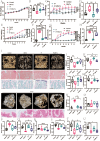Intermittent fasting triggers interorgan communication to improve the progression of diabetic osteoporosis
- PMID: 41025329
- PMCID: PMC12490001
- DOI: 10.1080/19490976.2025.2555619
Intermittent fasting triggers interorgan communication to improve the progression of diabetic osteoporosis
Abstract
Diabetic osteoporosis is a disease that seriously affects health, and intermittent fasting is a promising dietary approach to manage diabetes. The objective of our study was to analyze the effects of intermittent fasting on diabetic osteoporosis and its possible mechanisms. Streptozotocin-induced diabetes in mice was treated by intermittent fasting. Micro-CT and Immunostaining techniques were utilized to evaluate glycogen synthesis and morphological changes in the tibia. Gut microbiota analysis involved 16S rRNA gene amplification and sequencing. Liquid chromatography-mass spectrometry was employed, and quantitative real-time PCR assessed gene expression levels. Our study found that intermittent fasting improved blood glucose levels in diabetic mice and simultaneously enhanced cancellous bone microstructure, including BMD, BV/TV, Tb.Th, and Tb.Sp, which was revised by intervention with intermittent fasting. Intermittent fasting increased Christensenellaceae Chr) flora abundance. To further validate the role of Chr in diabetic osteoporosis treated with intermittent fasting, we used a gut microbiota transplanting and elimination experiment and Chr supplementation experiment, and the result found that Chr supplementation improved bone mass and microstructure in diabetic osteoporosis mice. In addition, Christensenellaceae facilitated the release of exosomes, which promote osteoclast activity, and exosome sequencing analysis showed miR551b upregulation in Christensenellaceae-derived exosomes, and the miR551b improves bone parameters in diabetic osteoporosis mice by supplement or inhibiting miR551b experiments. In conclusion, our study highlights the role of intermittent fasting in improving osteoporosis in diabetes by regulating changes in the abundance of Chr in the gut microbiota and improving the exosomes miR551b secreted by Chr, which in turn improves osteoblast activity. These findings provide a mechanism of intermittent fasting in managing osteoporosis via the gut microbiota-bone axis, potentially leading to innovative therapeutic approaches for diabetes-mediated osteoporosis.
Keywords: Christensenellaceae; Osteoporosis; diabetes mellitus; exosome; intermittent fasting; miR-551b.
Plain language summary
* “What is already known on this topic?” Diabetes often leads to bone metabolism disorders, and intermittent fasting can have a significant impact on the body’s metabolic state.* “What this study adds” Intermittent fasting led to significant improvements in blood glucose levels and bone mass in diabetic mice, as evidenced by enhanced cancellous bone microstructure parameters such as BMD, Tb.Sp, BV/TV, and Tb.Th.Intermittent fasting increased the abundance of Christensenellaceae flora, and KEGG pathway analysis revealed that RNA processing and modifications play a critical role in this process.Supplementation with Christensenellaceae-derived exosomes, compared to Lactobacillus-derived exosomes, showed superior effects on bone microstructure. The inhibition of miR-551b and the use of exosome inhibitors like GW4869 further demonstrated the role of miR-551b in bone healing.* “How this study might affect research, practice or policy” Our findings support the mechanism of intermittent fasting in managing osteoporosis via the gut microbiota-exosome-bone axis, potentially leading to innovative therapeutic approaches for diabetes-mediated osteoporosis.
Conflict of interest statement
No potential conflict of interest was reported by the author(s).
Figures








References
-
- Sun H, Saeedi P, Karuranga S, Pinkepank M, Ogurtsova K, Duncan BB, Stein C, Basit A, Chan JCN, Mbanya JC, et al. IDF diabetes Atlas: global, regional and country-level diabetes prevalence estimates for 2021 and projections for 2045. Diabetes Res Clin Pract. 2022;183:109119. doi: 10.1016/j.diabres.2021.109119. - DOI - PMC - PubMed
MeSH terms
Substances
LinkOut - more resources
Full Text Sources
Medical
